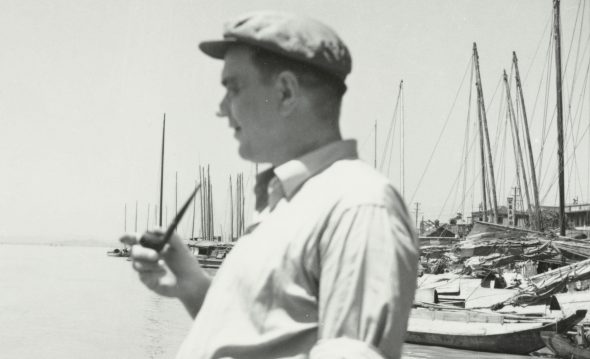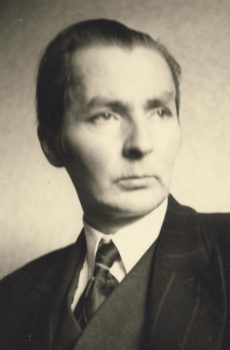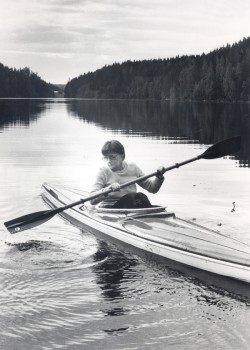Author: Aarne Kinnunen
The bad and the ugly in the writing of Pentti Haanpää
Issue 4/1984 | Archives online, Authors

Pentti Haanpää. Photo: SKS Archives
Pentti Haanpää (1905-1955), author of ten novels and three hundred short stories, wrote about lumberjacks, woodsmen, crofters and smallholders; his individual style has established him as one of the most popular short story writers in Finnish literature.
The first full biography of Haanpää, by Vesa Karonen, Haanpään elämä (‘Haanpää’s life’), is to be published in January 1985 by Finnish Literature Society.
Haanpää’s strength as a writer is in his short stories. He is a man’s writer who writes about a man’s world: logging and other heavy manual work, hiking, war hunting, fishing, sport. His language, too: is masculine: rugged, sometimes rough, dense, laconic. Haanpää’s scale of emotions is wide and varied, but there is a bass note that is often sounded in his work. It is one of the characteristics that gives Haanpää’s work its particular stamp: his preoccupation with the bad and the ugly. More…
Juha Mannerkorpi (1915–1989) and the metamorphosis of the self
Issue 2/1982 | Archives online, Authors

Juha Mannerkorpi. Photo: SKS Archives
The chapter, entitled ‘About calendars and other documents’, is a section of Juha Mannerkorpi’s book, Sudenkorento eli erään pakaraisen esittävät seikkailut (‘The dragonfly, or the representative adventures of a certain buttocks’, 1970). The main character is a writer, Caleb Buttocks, a long-term diabetic who can get around only on crutches and spends most of his days sitting in his room smoking and drinking beer. Pain and depression are his daily companions.
In the beginning, Caleb Buttocks attempts a real adventure: lifting himself out of the swamp like Baron von Münchhausen and going on an outing with his wife. The adventure comes to a bad end; he is not up to it. Thereafter, he has to be content with ‘representative adventures’: dreams, memories, and nightmares which are interwoven with the present time.
Sudenkorento is largely a first-person narrative which operates on many levels and the language of which is exceptionally rich. The narrator makes use of many different elements: fairy tales, poems, fantasies realistic narratives, and reminiscences. Sudekorento can be considered the most important book by Juha Mannerkorpi (1915-1980), and represents a synthesis of his earlier writing, which includes some twenty works since 1946: poems, plays, radio-plays, novels, and short stories. After the publication of Sudenkorento Mannerkorpi wrote a short diary-like work, Päivänsinet (‘Heavenly blue’, 1979), a study of the will to live in the shadow of a serious illness, diabetes, which is a subject he often dealt with in his work. Characteristic of Mannerkorpi’s writing are his analyses of the relationship of the self with the world and his explication of existential questions. In the European literary milieu, he is closest to Camus, Sartre and Beckett, all of whom he has translated into Finnish. More…
On Eeva-Liisa Manner
Issue 4/1978 | Archives online, Authors

Eeva-Liisa Manner. Photo: Tammi.
It is difficult to discuss Eeva-Liisa Manner’s poetry in isolation from her other writing. In both prose and drama she is a significant figure in Finnish literature, and, for instance, one of her plays – Poltettu oranssi (‘The burnt-out orange’) – had a nine-year run at the Tampere Workers’ Theatre.
Seen from one angle, a Manner poem is an opportunity to speak, to have a say on the day’s occurrences, such as the occupation of Czechoslovakia in 1968. Yet a poem of hers is always distanced. Perhaps it is mediated through the eternal myth of the East and West; or perhaps the events are seen from some altered perspective – from ‘a distant present’. Our own time may be seen, for example, from the point of view of the Cambrian Age. Myths and the animals associated with myth are consciously brought forward by the ‘I’ of the poems, always with a delicate irony. The horse is the most prominent and beloved of these beasts (the Creator ‘succeeded best’ with him), and he is identified with Jung’s animus. Discursive philosophy is not prominent in Finland. Finnish philosophers tend to be philosophers of science and technology – the purveyors of wisdom are the poets, and they are by no means bad at it. Taking a risk with the reader’s indulgence I could define Eeva-Liisa Manner as a philosophical poet meaning that her lyricism is charged with implication. The fine control of semantic content, as always in lyrical poetry, is achieved through her imagery and music; but her thematic centres, the problems she confronts, are seriously or ironically philosophical. In some of her poems, such as ‘A Logical Tale’. she may actually build up the lyric within an apparently tight case of thought; this is, of course, both a dig at philosophy and a philosophical point. Sometimes the digs are very hard. The nuances are many. More…
-
About the author
Aarne Kinnunen (b. 1930) is an emeritus professor of aesthetics at the University of Helsinki. His Ph.D. thesis (1967) was on Aleksis Kivi, who is known as Finland’s national author. His academic scholarship focused on literature and theatre as well as aesthetics.
© Writers and translators. Anyone wishing to make use of material published on this website should apply to the Editors.
